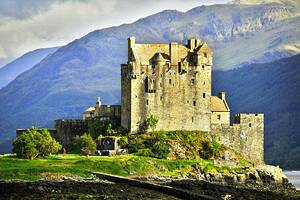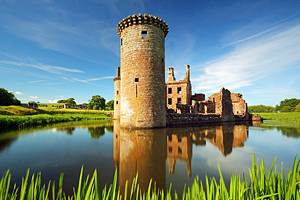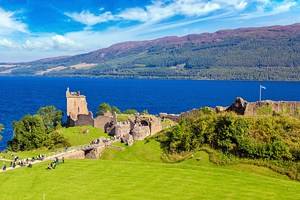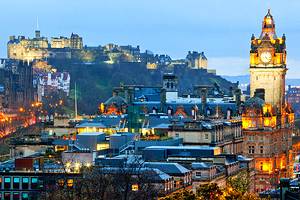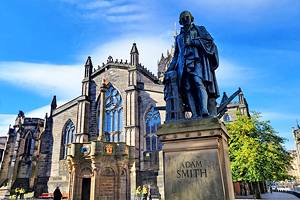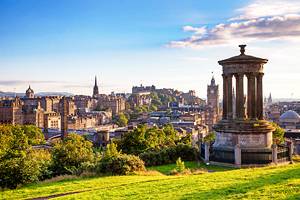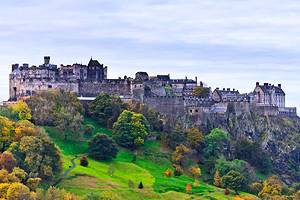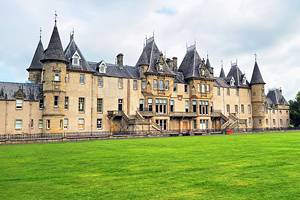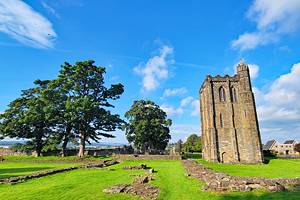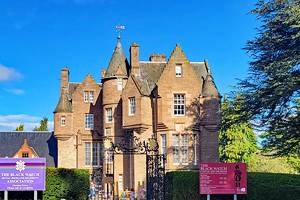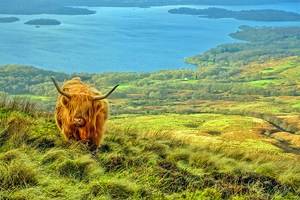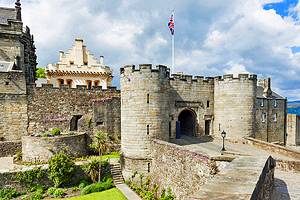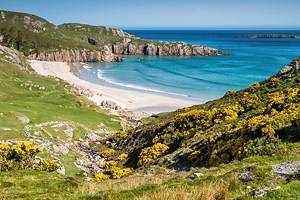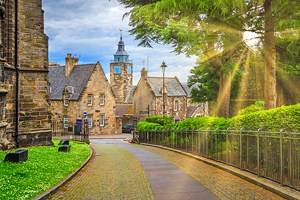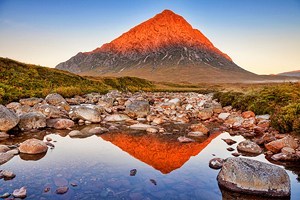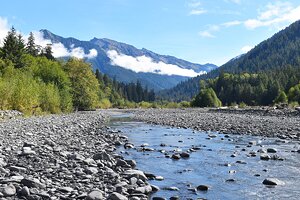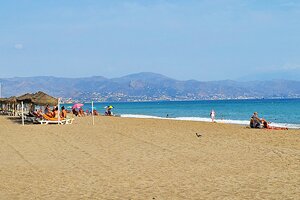16 Top-Rated Day Trips from Edinburgh
As hard as it might be to pull yourself away from the many rewarding things to do in Edinburgh, the area around this stunningly attractive city is equally worth your time exploring.
This region of "Bonnie Scotland" contains no end of wonderful attractions and historic places to visit. A drive in almost any direction will unveil dramatic coastlines, magnificent mountains, and countless incredible historic sites. Castles, grand homes, and abbeys make up the bulk of the tourist attractions in the area, and all are waiting to be explored.
Be sure to plan your adventures with this list of the best day trips from Edinburgh, Scotland.
- Stirling Castle
- Loch Lomond and the West Highlands Castles
- Loch Ness and the Scottish Highlands
- Outlander Film Locations Day Trip
- Linlithgow Palace
- St. Andrews and Fife
- National Mining Museum Scotland
- Melrose Abbey and Rosslyn Chapel
- Holy Island and Alnwick Castle
- Crichton Castle
- Dalmeny House and Hopetoun House
- Sir Walter Scott's Abbotsford House
- Jedburgh Abbey
- Kelso and Floors Castle
- National Museum of Flight
- Thirlestane Castle
- Map of Day Trips from Edinburgh
Stirling Castle

About 45 minutes from Edinburgh by direct train, the town of Stirling is a popular destination for tourists for its spectacular 12th-century castle. Beautiful Stirling Castle stands high above the town at the top of a 76-meter volcanic crag, and has played an important role in Scotland's history.
Highlights of a visit include the Great Hall, built for James IV in 1503 and an impressive and well-preserved medieval structure. Be sure to also allow time to explore the lovely Queen Anne Gardens adjacent to the castle.
Stirling is also the site of two major Scottish victories over the English. The first was in 1314 when Robert the Bruce defeated them at the Battle of Bannockburn. It was also here that William Wallace defeated the English at the Battle of Stirling Bridge. Both battles are explored at the Bannockburn Heritage Centre, and Wallace is commemorated by the impressive Wallace Monument just outside of town on the road to the attractive small Scottish town of Bridge of Allan.
Address: Castle Wynd, Stirling, Scotland
Official site: www.stirlingcastle.scot
Loch Lomond and the West Highlands Castles

Legendary Loch Lomond, Scotland's largest freshwater loch, is situated at the southern end of Loch Lomond & the Trossachs National Park. This beautiful loch is a center for boating and other water sports, and the gateway to the beautiful West Highlands.
Here, among the hills and rugged Breadalbane Mountains, you'll find a number of historic castles, including Inveraray Castle. The seat of the Dukes of Argyll, Inveraray was built in the mid-18th century on the foundations of a medieval fortress.
Movie buffs may recognize Doune Castle as the filming location for Monty Python and The Holy Grail.
Loch Ness and the Scottish Highlands

By far the best-known of Scotland's fabled lochs is Loch Ness, reputed home of the sea serpent, Nessie. Filling the deep geological fissure known as the Great Glen, Loch Ness is 37 kilometers long (with a depth of 227 meters), with mountains rising steeply from its banks.
It's undoubtedly one of the loveliest places to visit in all of Scotland, and hour-long boat trips from Fort Augustus and Inverness reveal magnificent views of the Scottish Highlands' rocky peaks. They also provide great views of the romantic ruins of Urquhart Castle.
Outlander Film Locations Day Trip

A popular organized tour for day-trippers and TV-viewers alike, the Outlander film locations day trip is a great option for Edinburgh-based tourists. Departing Highland Explorer Tours' central Edinburgh office at 8:45am, your adventure takes in some of the area's most spectacular scenery, as well as top places to visit that starred in the hit TV show.
Along the way, a professional guide shares not just the real history of these locations, but anecdotes about the fictional locations they represent. They also share stories about the show's imaginary characters.
Tourist attractions you'll see along the way include Doune Castle, a well-preserved medieval fortress that stood in for Castle Leoch. Also included are the quaint village of Culross, called Cranesmuir in the series, and the town of Falkirk, which was used to film the wartime scenes of Inverness.
Other highlights include visits to Linlithgow Palace, Aberdour, and Midhope Castle.
Linlithgow Palace

Set in an attractive lakeside location, Linlithgow Palace – a star of the hit Outlander TV series – is famous as the birthplace of Mary Stuart in 1542. The gatehouse on the east front still bears the royal coat-of-arms.
The long Great Hall gives some idea of the palace's splendor, and guides can point out the location of the room, far above, where the future queen was born. You can also walk the castle's ramparts and explore its towers.
Make sure you allow time to explore the pleasant little village of Linlithgow. Here, you'll find historic St. Michael's Church and some lovely 16th-century houses. Nearby Cairnpapple Hill is a prehistoric site dating to 3000 BC.
A still-inhabited country house between Linlithgow and Queensferry, the House of Binns is of particular interest for its stone chimneys and mid-17th-century stucco ceilings in the High Hall. In the King's Room, tourists can see the heraldic emblems of England and Scotland joined in the decor.
Address: Kirkgate, Linlithgow, Scotland
Official site: www.historicenvironment.scot/visit-a-place/places/linlithgow-palace/
St. Andrews and Fife

Although the name St. Andrews is hallowed to golfers, you don't have to play golf to appreciate this old university town in Fife, a scenic 90-minute drive north of Edinburgh.
Along with several courses and the British Golf Museum, there are the haunting ruins of the 12th-century cathedral and the picturesque St. Andrew's Castle on a promontory overlooking the North Sea. Parts of it date to the 13th century, when it was home to the archbishop.
On the way back to Edinburgh, visit the fishing villages of East Neuk and Falkland, where you'll see the imposing Falkland Palace.
National Mining Museum Scotland

The National Mining Museum Scotland is located about 16 kilometers south of Edinburgh at the Lady Victoria Colliery, one of the best preserved Victorian Collieries in Europe. Considered one of the best mines to visit in Scotland, it opened in 1894 and ceased production in 1981.
The museum traces the developments in mining the prolific Scottish coalfields over several generations. Of greatest historical interest is the Grant-Richie winding engine once used to lift coal from a depth of almost 1,640 feet. In addition to the winch, this four-acre site also includes a superbly preserved set of Lancashire Boilers and Europe's only extant timber dredger. Fun pithead tours are available.
Another interesting mining-related attraction is Prestongrange Museum a few miles west of Edinburgh. Its underground gallery offers a fascinating glimpse into the tough life of a miner. Also worth visiting is the quaint former mining village of Roslin, just five miles south of Edinburgh.
Address: Lady Victoria Colliery, Newtongrange, Dalkeith, Scotland
Official site: http://nationalminingmuseum.com
Melrose Abbey and Rosslyn Chapel

Many regard Melrose Abbey as the finest of the Borders region's four abbeys. Built from red sandstone for Cistercian monks in 1136, it was plundered and desecrated on several occasions.
What remains makes an impressive sight. Highlights include the ornate stonework and carvings of gargoyles on the capitals and sculptures, and a fountain in the form of a bagpipe-playing pig. It's said that the heart of Robert the Bruce is buried beneath the east window, and a mummified heart was in fact found in the Chapterhouse in 1920.
A day trip to Melrose Abbey is easily combined with a visit to the fascinating and enigmatic Rosslyn Chapel. This attractive location was brought to wide public attention for its role in the hit movie, The Da Vinci Code. The unusual stone carvings are the subject of a lot of speculation, and the chapel is reputed to have strong association with the Knights Templar and Freemasonry. Whatever its true history, the chapel is a beautiful place.
Address: Abbey Street, Melrose, Scotland
Official site: www.historicenvironment.scot/visit-a-place/places/melrose-abbey/
Holy Island and Alnwick Castle

Edinburgh is close enough to the English border to make a day trip along the beautiful coast of Northumberland possible. The highlight of this rugged coast is Holy island, a mystical place with a long history, reached from the mainland only at low tide across a narrow sandbar.
Sitting at the top of a steep hill is picture-perfect Lindisfarne Castle. This imposing fortress was built in the 1500s using stones from the priory that was founded here in 635 by Saint Aidan, who came from the Scottish island of Iona.
The Holy Island is not far from Alnwick Castle. Often called the "Windsor of the North" for its imposing towers and opulent interiors, it was used as a location for scenes from Downton Abbey and the Harry Potter films.
Along with the sumptuous interior, you can tour the magnificent gardens, among the finest in England. The most unusual features here are the poison garden and the beautiful cascade fountain. Be sure to check for opening times during the shoulder season, as the castle does close over the winter months.
Address: Alnwick, Northumberland, England
Official site: www.alnwickcastle.com
Crichton Castle

Perched atop a hill overlooking the River Tyne and just 12 miles east of Edinburgh stands Crichton Castle. Praised by Walter Scott in Marmion, the original 14th century tower house had three wings and an Italianate elegance with Florentine arcades. The castle's facade and brickwork were enhanced with diamond bosses.
Mary Stuart and Lord Darnley stayed here during their honeymoon, and their initials (MSD) can still be seen carved into a stone over the two central pillars on the east side of the courtyard. If visiting, be sure to keep an eye out for the castle's ghost.
Another nearby castle worth a visit is Lauriston Castle, located just four miles northwest of Edinburgh. Highlights of a visit to this picturesque tower house dating from the 1500s include its beautiful gardens. This is one of the top free things to do in southern Scotland. You'll find here a delightful Japanese garden, along with spectacular views over the Firth of Forth.
There are also a number of easy woodland trails to follow. It's especially fun to walk here in spring when the bluebells are in bloom. The on-site café is also worth visiting.
Address: Crichton, Pathhead, Scotland
Official site: www.historicenvironment.scot/visit-a-place/places/crichton-castle/
Dalmeny House and Hopetoun House

Just eight miles northwest of Edinburgh in Queensferry stands Dalmeny House. Set overlooking the Firth of Forth, it's famous for its Tudor Gothic style, valuable art treasures – including portraits by Reynolds, Raeburn, and Gainsborough – and French furniture from the time of Louis XV and Louis XVI.
Other highlights include rare porcelain and tapestries, as well as silk curtains embroidered by Marie Antoinette. The Napoleon Room contains paintings and personal effects belonging to the Emperor, as well as a seat used by the Duke of Wellington.
While in Dalmeny, visit St. Cuthbert's church. This impressive structure dates from the 12th century and is notable for its richly decorated south portal and some fine woodcarving. Also of interest in South Queensferry is 17th-century Hopetoun House with its many splendid rooms decorated with damask wallpaper, tapestries, delightful stucco ceilings, and fine furniture.
Address: South Queensferry, Scotland
Official site: www.dalmeny.co.uk
Sir Walter Scott's Abbotsford House

At the heart of "Scott's country," as the Scottish Borders south of Edinburgh are sometimes known, lies Abbotsford. Located on the banks of the Tweed, it was here Sir Walter Scott wrote the majority of his poems and historical novels, and where he died in 1832.
The royalties from his highly successful novels went towards converting the farmhouse into the present Scottish-style mansion. The house is crammed full of reminders of the best-selling writer, including manuscripts, ballads, portraits and curiosities such as Bonnie Prince Charlie's scotch glass (quaich), the sword used by outlaw Rob Roy, and Scott's death mask.
Guided tours of the home and gardens are available, while those wanting to experience a night's stay can do so in one of its luxury accommodations. There's also a great tearoom on-site that serves a lovely afternoon "high tea" experience.
Address: Abbotsford, Melrose, Roxburghshire, Scotland
Official site: www.scottsabbotsford.com
Jedburgh Abbey

The remains of Jedburgh Abbey is perhaps the most beautiful of the four 12th-century Border abbeys destroyed by the English in 1544. The site consists of two Norman arches and the west front with its magnificent rose window (the St. Catherine's Wheel).
The arcades in the three-story main nave and the window tracery are also worth a look, while the visitor center has an exhibition explaining the day-to-day life of the monks. Guided tours are also available.
Dryburgh Abbey, just eight miles away from Jedburgh, is another of the Borders' former abbeys. Although little of it is left, you can still visit the marvelous west portal, the rose window at the west end of the refectory, the chapterhouse, and St. Modan's Chapel.
Address: Abbey Bridge End, Jedburgh, Scotland
Official site: www.historicenvironment.scot/visit-a-place/places/jedburgh-abbey
Kelso and Floors Castle

Walter Scott described Kelso as the "prettiest, if not the most romantic village in Scotland." This attractive market town 10 miles east of Melrose has a Georgian market square that's fun to explore. The five-arched bridge over the Tweed was built in 1803 and offers views of the ruined abbey.
But the most famous sightseeing landmark, however, is Floors Castle. This fairy-tale castle, topped with small towers, ornate turrets, and chimneys, was built in Georgian style in 1721 and was later extended in decorative Tudor style.
The castle's valuable collection of porcelain includes examples from Dresden and Meissen, Davenport tableware, and items dating from the Chinese Ming dynasty. It's also home to a number of important portraits by Gainsborough and Reynolds.
It's also worth having a look at the collection of Victorian coaches, prams, and bathing machines before taking a stroll through the beautiful gardens. One of the trees in the extensive parkland is said to mark the spot where James II was fatally wounded by a bullet during a siege of the castle in 1460. Afterwards, be sure to reserve a spot of tea in the tearoom (book at least 24 hours ahead of your visit).
Address: Roxburghe Estates Office, Kelso, Scotland
Official site: www.floorscastle.com/
National Museum of Flight

The National Museum of Flight is housed in a former RAF airbase and includes over 30 vintage airplanes. Among them are a De Havilland Puss Moth (1930), a Weir W-2 (1934), a Supermarine Spitfire, and a Sea Hawk. Also on display is the famous Concorde jetliner, a Nimrod, and numerous displays related to flight during two world wars.
While in Linton, be sure to visit 13th-century Hailes Castle with its narrow dungeons. For some outdoor sightseeing, stop in the coastal village of Aberlady, noted for its fine sandy beaches and seabird reserve.
Address: East Fortune Airfield, North Berwick, Scotland
Official site: www.nms.ac.uk/national-museum-of-flight
Thirlestane Castle

Another historic property in the Scottish Borders that's well worth a visit is Thirlestane. It's just a 20-minute drive from Sir Walter Scott's Abbotsford home, making it an ideal way to extend that particular day trip (see above).
This 13th-century border fortress was converted into a stately home and boasts splendid wooden ceilings, a collection of old toys, and the Border Country Life Exhibitions. Luxury stays are also available at this castle, and make for an idyllic Scottish countryside getaway.
Location: Lauder, Scotland
Official site: www.thirlestanecastle.co.uk
Map of Day Trips from Edinburgh
More Related Articles on PlanetWare.com
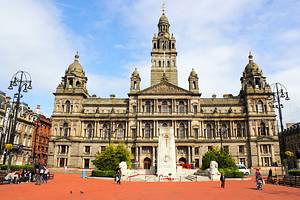
Scotland Travel Ideas: Scotland's other big city, Glasgow, also makes a great base from which to enjoy fun day trips. Places to visit in Glasgow itself include its lovely cathedral, its historic school of art, along with its many museum and art galleries. Farther north is the attractive city of Aberdeen, known as the "Flower of Scotland" for its many gardens and parks. The cities of Ayr and Dumfries are also worth including in your Scotland itinerary and are best known for their connections to the country's most famous poet, Robbie Burns.


